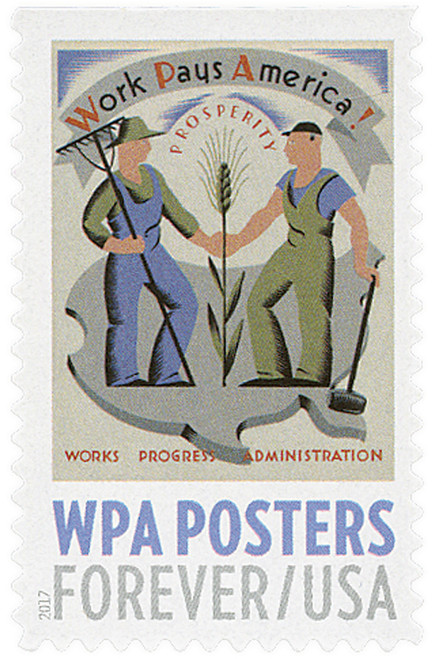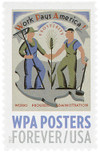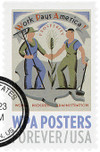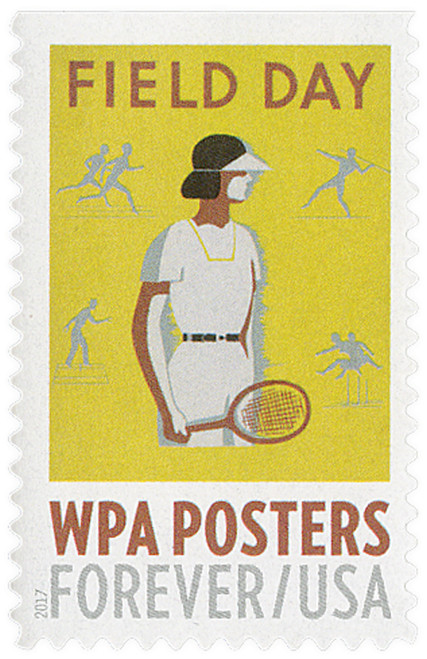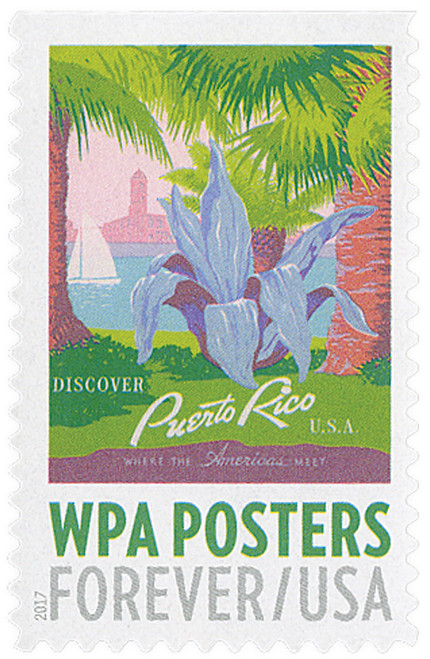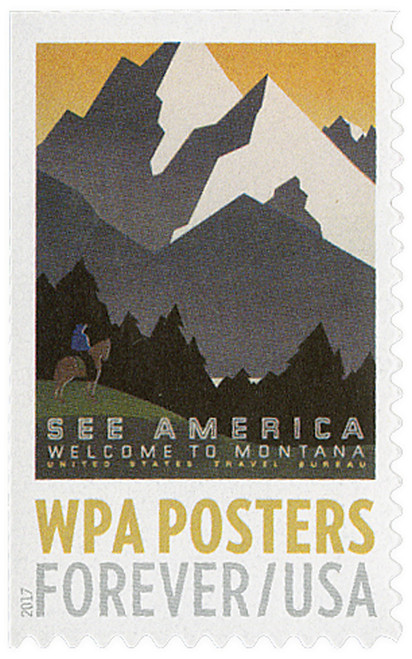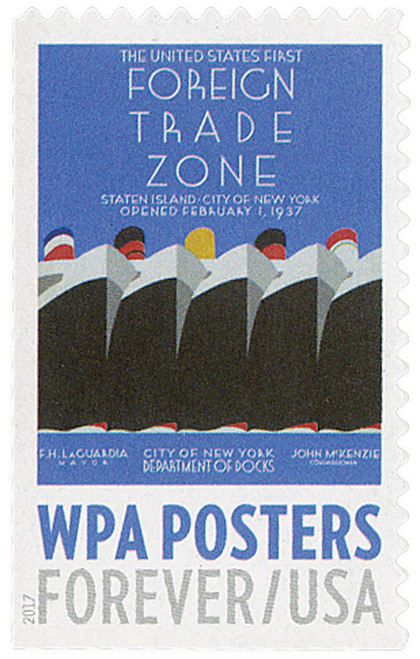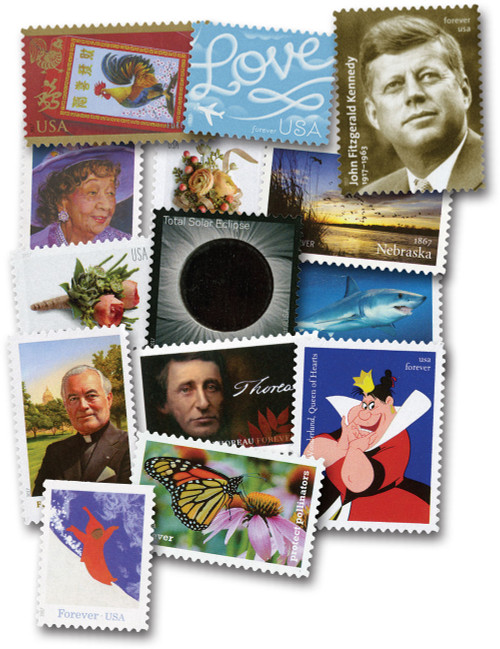
# 5181 - 2017 First-Class Forever Stamp - WPA Posters: Work Pays America!
US #5181
2017 Work Pays America! – WPA Posters
- Pictures famous Workers Projects Administration (WPA) poster
Stamp Category: Commemorative
Set: WPA Posters
Value: 49¢ First Class Mail Rate (Forever)
First Day of Issue: March 7, 2017
First Day City: Hyde Park, New York
Quantity Issued: 100,000,000
Printed by: Ashton Potter (USA) Ltd.
Printing Method: Offset
Format: Double-Sided Booklets of 20
Tagging: Nonphosphored type III, overall
Why the stamp was issued: To commemorate the Workers Projects Administration (WPA) and its many accomplishments.
About the stamp design: Pictures the “Work Pays America!” WPA poster from the Prints & Photographs Division of the Library of Congress. Designed by Maribel O. Gray in collaboration with art director Antonio Alcalá. The poster was created to support the ideas of President Franklin D. Roosevelt and his New Deal programs.
First Day City: The First Day of Issue Ceremony was held at the Franklin D. Roosevelt Presidential Library and Museum in Hyde Park, New York.
About the WPA Posters set: Includes 10 different stamp designs picturing different WPA posters from the era of FDR’s New Deal. Issued to celebrate the Workers Projects Administration and its contributions to the economy and American culture.
History the stamps represent: The Stock Market Crash of 1929 and the Great Depression wreaked havoc on the American economy. Wages were cut, businesses closed, and by 1933, nearly 15 million Americans were unemployed. But newly elected President Franklin Roosevelt offered Americans his New Deal to help improve their lives and end the Depression.
Over the next few years, Roosevelt introduced a record number of bills aimed at stimulating the economy and helping American workers. Among these was the National Labor Relations Act of 1935. Also known as the Wagner Act (after Senator Robert F. Wagner), it gave private sector employees the right to organize into trade unions, participate in collective bargaining, and strike if necessary.
While the legislation did not apply to farm workers, other acts and organizations were later created to help them, namely the Farm Security Administration. Formed in 1937, the FSA offered education to struggling farm families to help them become self-sustaining. It also set up homestead communities, which taught farmers a better way to work.
These programs, as well as the institution of a federal minimum wage and 40-hour work week in 1938, were major steps in improving the lives of millions of Americans during and after the Depression.
US #5181
2017 Work Pays America! – WPA Posters
- Pictures famous Workers Projects Administration (WPA) poster
Stamp Category: Commemorative
Set: WPA Posters
Value: 49¢ First Class Mail Rate (Forever)
First Day of Issue: March 7, 2017
First Day City: Hyde Park, New York
Quantity Issued: 100,000,000
Printed by: Ashton Potter (USA) Ltd.
Printing Method: Offset
Format: Double-Sided Booklets of 20
Tagging: Nonphosphored type III, overall
Why the stamp was issued: To commemorate the Workers Projects Administration (WPA) and its many accomplishments.
About the stamp design: Pictures the “Work Pays America!” WPA poster from the Prints & Photographs Division of the Library of Congress. Designed by Maribel O. Gray in collaboration with art director Antonio Alcalá. The poster was created to support the ideas of President Franklin D. Roosevelt and his New Deal programs.
First Day City: The First Day of Issue Ceremony was held at the Franklin D. Roosevelt Presidential Library and Museum in Hyde Park, New York.
About the WPA Posters set: Includes 10 different stamp designs picturing different WPA posters from the era of FDR’s New Deal. Issued to celebrate the Workers Projects Administration and its contributions to the economy and American culture.
History the stamps represent: The Stock Market Crash of 1929 and the Great Depression wreaked havoc on the American economy. Wages were cut, businesses closed, and by 1933, nearly 15 million Americans were unemployed. But newly elected President Franklin Roosevelt offered Americans his New Deal to help improve their lives and end the Depression.
Over the next few years, Roosevelt introduced a record number of bills aimed at stimulating the economy and helping American workers. Among these was the National Labor Relations Act of 1935. Also known as the Wagner Act (after Senator Robert F. Wagner), it gave private sector employees the right to organize into trade unions, participate in collective bargaining, and strike if necessary.
While the legislation did not apply to farm workers, other acts and organizations were later created to help them, namely the Farm Security Administration. Formed in 1937, the FSA offered education to struggling farm families to help them become self-sustaining. It also set up homestead communities, which taught farmers a better way to work.
These programs, as well as the institution of a federal minimum wage and 40-hour work week in 1938, were major steps in improving the lives of millions of Americans during and after the Depression.

